Non-Uniform Temperature Field of Spatial Grid Structure under Construction Induced by Solar Radiation
Abstract
:1. Introduction
2. Experimental Programs of Temperature Field Test of Spatial Grid Structure
2.1. Design of Test Model
2.2. Test Content and Equipment
2.3. Arrangement of Test Points
3. Analysis of Temperature Field Test Results
3.1. Temperature Field Distribution of Structure Model
3.2. Comparison of Temperature Characteristics of Different Type Members
4. Numerical Simulation of Temperature Field of Spatial Grid Structure
4.1. Finite Element Model
4.2. Shadow Analysis of Spatial Grid Structure
4.3. Comparative Analysis of Numerical Results and Test Results
5. Conclusions
- (1)
- The spatial grid structure model has a non-uniform temperature distribution. The maximum temperature is 47 °C, the difference between maximum temperatures and the ambient temperature is 16 °C, and the temperature difference is a maximum of 11 °C. These results are expected to be higher for intense solar radiation.
- (2)
- The temperature variations of the chord members are similar, regardless of their in-plane angle. The space angle has a significant influence on the temperature field of web members, but the web members with the same space angle and different positions are similar.
- (3)
- The ray-casting algorithm is introduced to the numerical simulation method for the non-uniform temperature field of the spatial grid structure, which can accurately calculate the real-time shadow distribution of the spatial grid structure.
- (4)
- The numerical simulation results of the non-uniform temperature field match well with the measured results. The average error rate throughout the daytime is only 5.3%. This proves that the numerical method for the temperature field analysis of the spatial grid structure is reliable and effective.
Author Contributions
Funding
Conflicts of Interest
References
- Liu, H.; Liao, X.; Chen, Z.; Zhang, Q. Thermal Behavior of Spatial Structures under Solar Irradiation. Appl. Therm. Eng. 2015, 87, 328–335. [Google Scholar] [CrossRef]
- Chen, D.; Qian, H.; Wang, H.; Chen, Y.; Fan, F.; Shen, S. Experimental and numerical investigation on the non-uniform temperature distribution of thin-walled steel members under solar radiation. Thin Wall Struct. 2018, 122, 242–251. [Google Scholar] [CrossRef]
- Tong, M.; Tham, L.G.; Au, F.T.K. Numerical Modeling for Temperature Distribution in Steel Bridges. Comput. Struct. 2001, 79, 583–593. [Google Scholar] [CrossRef]
- Tong, M.; Tham, L.G.; Au, F.T.K. Extreme Thermal Loading on Steel Bridges in Tropical Region. J. Bridge Eng. 2002, 7, 357–566. [Google Scholar] [CrossRef]
- Kim, S.; Cho, K.; Won, J.; Kim, J. A Study on Thermal Behaviour of Curved Steel Box Girder Bridges Considering Solar Radiation. Arch. Civ. Mech. Eng. 2009, 9, 59–76. [Google Scholar] [CrossRef]
- Kromanis, R.; Kripakaran, P.; Harvey, B. Long-term structural health monitoring of the Cleddau bridge: Evaluation of quasi-static temperature effects on bearing movements. Struct. Infrastruct. Eng. 2016, 12, 1342–1355. [Google Scholar] [CrossRef]
- Yarnold, M.T.; Moon, F.L. Temperature-based structural health monitoring baseline for long-span bridges. Eng. Struct. 2015, 86, 157–167. [Google Scholar] [CrossRef]
- Westgate, R.; Koo, K.Y.; Brownjohn, J. Effect of Solar Radiation on Suspension Bridge Performance. J. Bridge Eng. 2015, 20, 04014077. [Google Scholar] [CrossRef] [Green Version]
- Westgate, R.J.; Brownjohn, J.M.W. Development of a Tamar Bridge Finite Element Model. In Dynamics of Bridges, Proceedings of the Society for Experimental Mechanics Series, Jacksonville, FL, USA, 1–4 February 2010; Springer: New York, NY, USA, 2011. [Google Scholar]
- Fan, F.; Jin, X.; Shen, S. Effect of non-uniform solar temperature field on cable-net structure of reflector of large radio telescope-FAST. Adv. Struct. Eng. 2009, 12, 503–512. [Google Scholar] [CrossRef]
- Chen, D.; Qian, H.; Wang, H.; Zhang, G.; Fan, F.; Shen, S. Non-uniform temperature field measurement and simulation of a radio telescope’s main reflector under solar radiation. Appl. Therm. Eng. 2017, 111, 1330–1341. [Google Scholar] [CrossRef]
- Chen, D.; Wang, H.; Qian, H.; Zhang, G.; Shen, S. Solar cooker effect test and temperature field simulation of radio telescope subreflector. Appl. Therm. Eng. 2016, 109, 147–154. [Google Scholar] [CrossRef]
- Liu, H.; Li, B.; Chen, Z.; Zhou, T.; Zhang, Q. Solar Radiation Properties of Common Membrane Roofs Used in Building Structures. Mater. Des. 2016, 105, 268–277. [Google Scholar] [CrossRef]
- Liu, H.; Chen, Z.; Chen, B.; Xiao, X.; Wang, X. Studies on the Temperature Distribution of Steel Plates with Different Paints under Solar Radiation. Appl. Therm. Eng. 2014, 71, 342–354. [Google Scholar] [CrossRef]
- Liu, H.; Chen, Z.; Zhou, T. Theoretical and Experimental Study on the Temperature Distribution of H-shaped Steel Members under Solar Radiation. Appl. Therm. Eng. 2012, 37, 329–335. [Google Scholar] [CrossRef]
- Chen, D.; Wang, H.; Qian, H.; Li, X.; Fan, F.; Shen, S. Experimental and numerical investigation of temperature effects on steel members due to solar radiation. Appl. Therm. Eng. 2017, 127, 696–704. [Google Scholar] [CrossRef]
- Liu, H.; Chen, Z.; Han, Q.; Chen, B.; Bu, Y. Study on the thermal behavior of aluminum reticulated shell structures considering solar radiation. Thin Wall Struct. 2014, 85, 15–24. [Google Scholar] [CrossRef]
- Zhao, Z.; Liu, H.; Chen, Z. Field Monitoring and Numerical Analysis of Thermal Behavior of Large Span Steel Structures under Solar Radiation. Adv. Steel Constr. 2017, 13, 190–205. [Google Scholar]
- Zhao, Z.; Zhu, H.; Liu, H.; Chen, Z. Thermal and integral lifting analysis of a lattice shell lighting roof based on genetic algorithm and probabilistic design. J. Constr. Steel Res. 2015, 112, 208–220. [Google Scholar] [CrossRef]
- Zhao, Z.; Liu, H.; Chen, Z. Thermal behavior of large-span reticulated domes covered by ETFE membrane roofs under solar radiation. Thin Wall Struct. 2017, 115, 1–11. [Google Scholar] [CrossRef]
- Albert, G.; Michael, B. Thermal Design and Thermal Behavior of Radio Telescopes and Their Enclosures; Springer: Berlin/Heidelberg, Germany, 2010; pp. 55–159. [Google Scholar]
- Levoy, M. Display of surface from volume data. IEEE Comput. Graph 1988, 8, 29–37. [Google Scholar] [CrossRef] [Green Version]
- Carboni, B.; Lacarbonara, W. A three-dimensional continuum approach to the thermoelastodynamics of large-scale structures. Eng. Struct. 2012, 40, 155–167. [Google Scholar] [CrossRef]
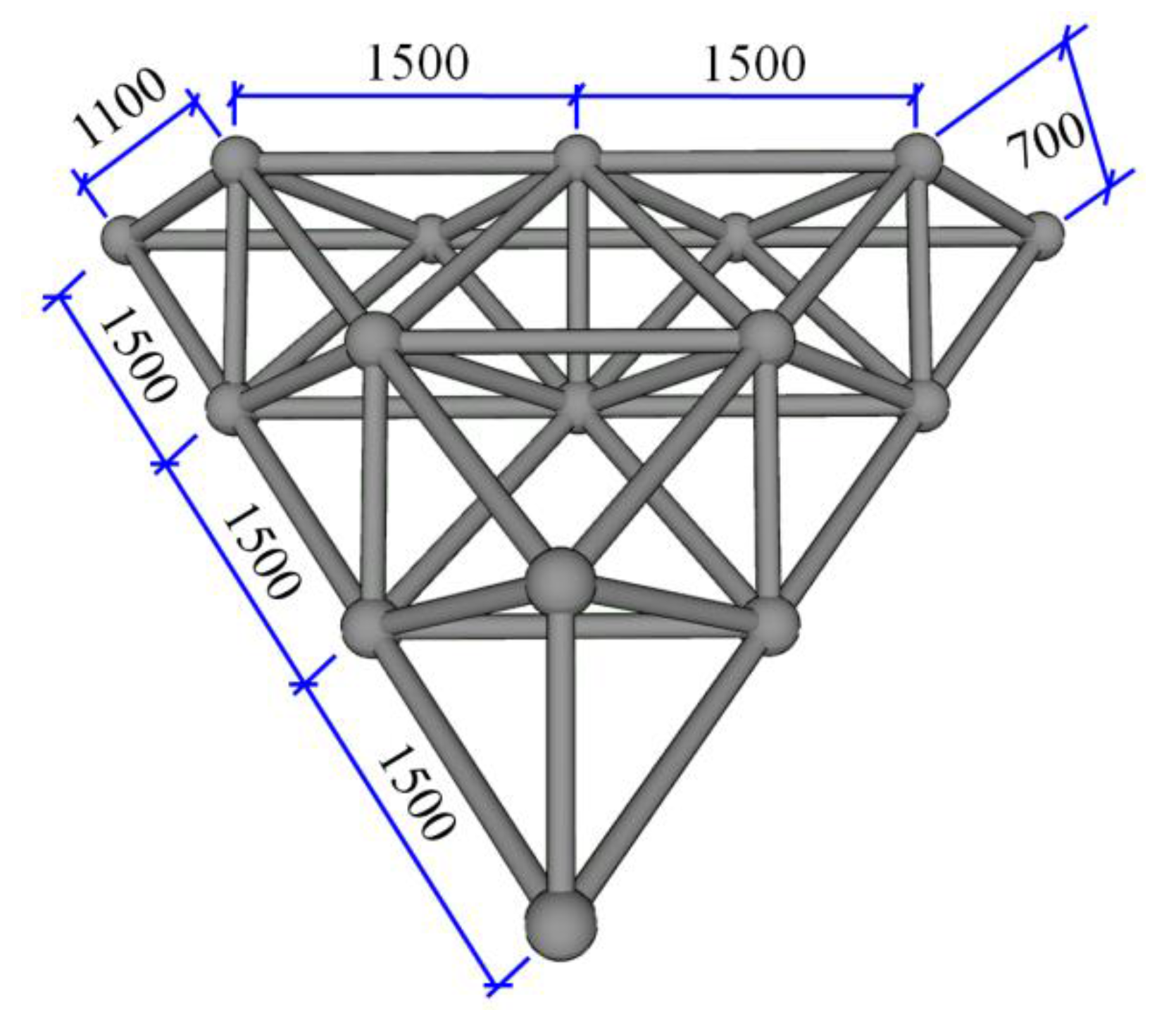

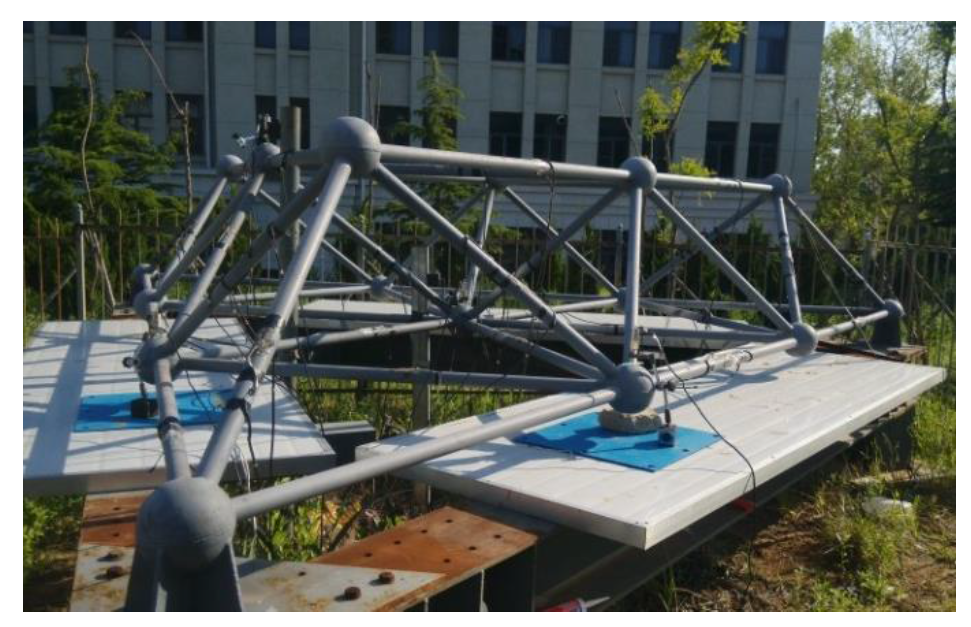
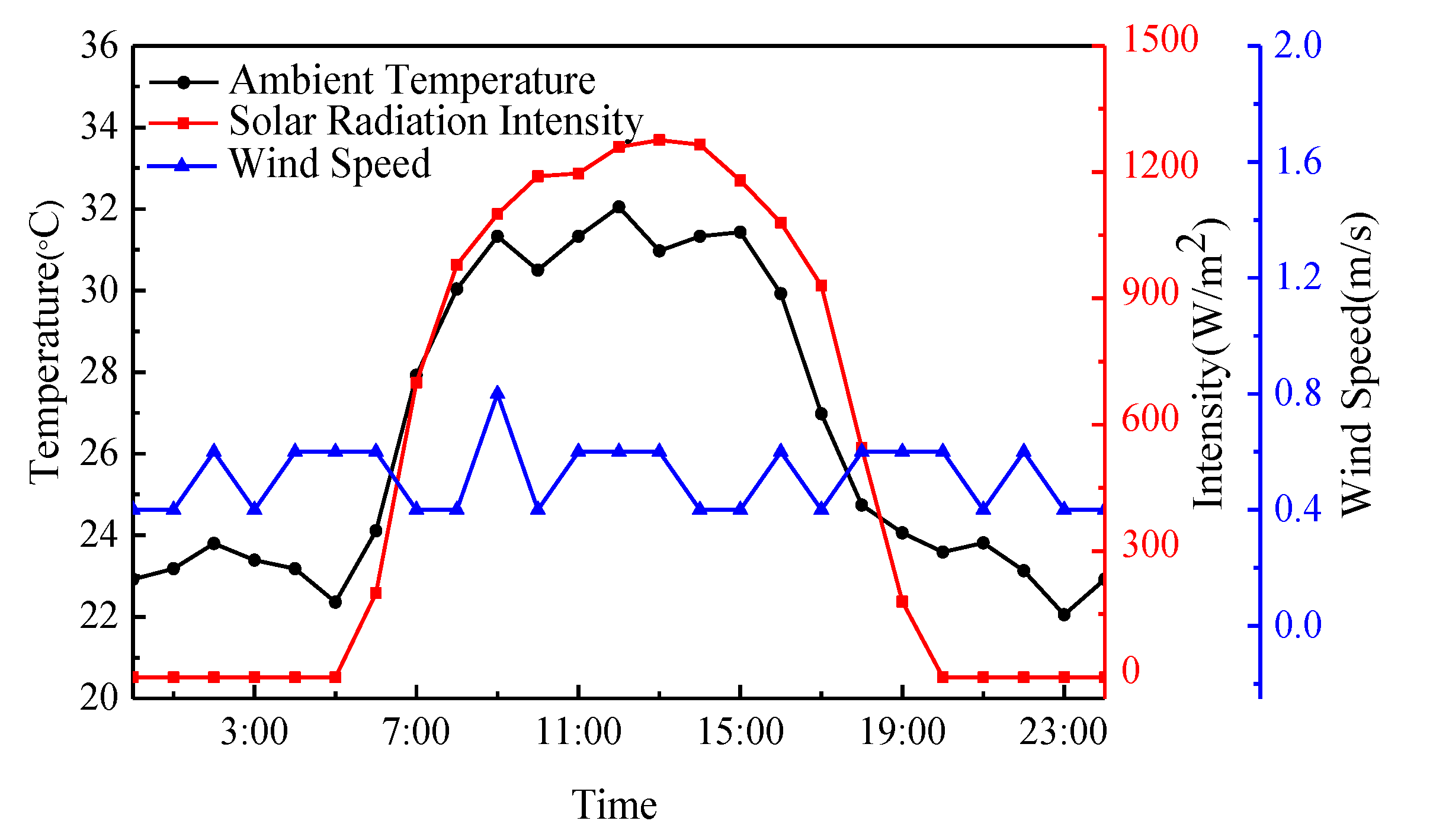



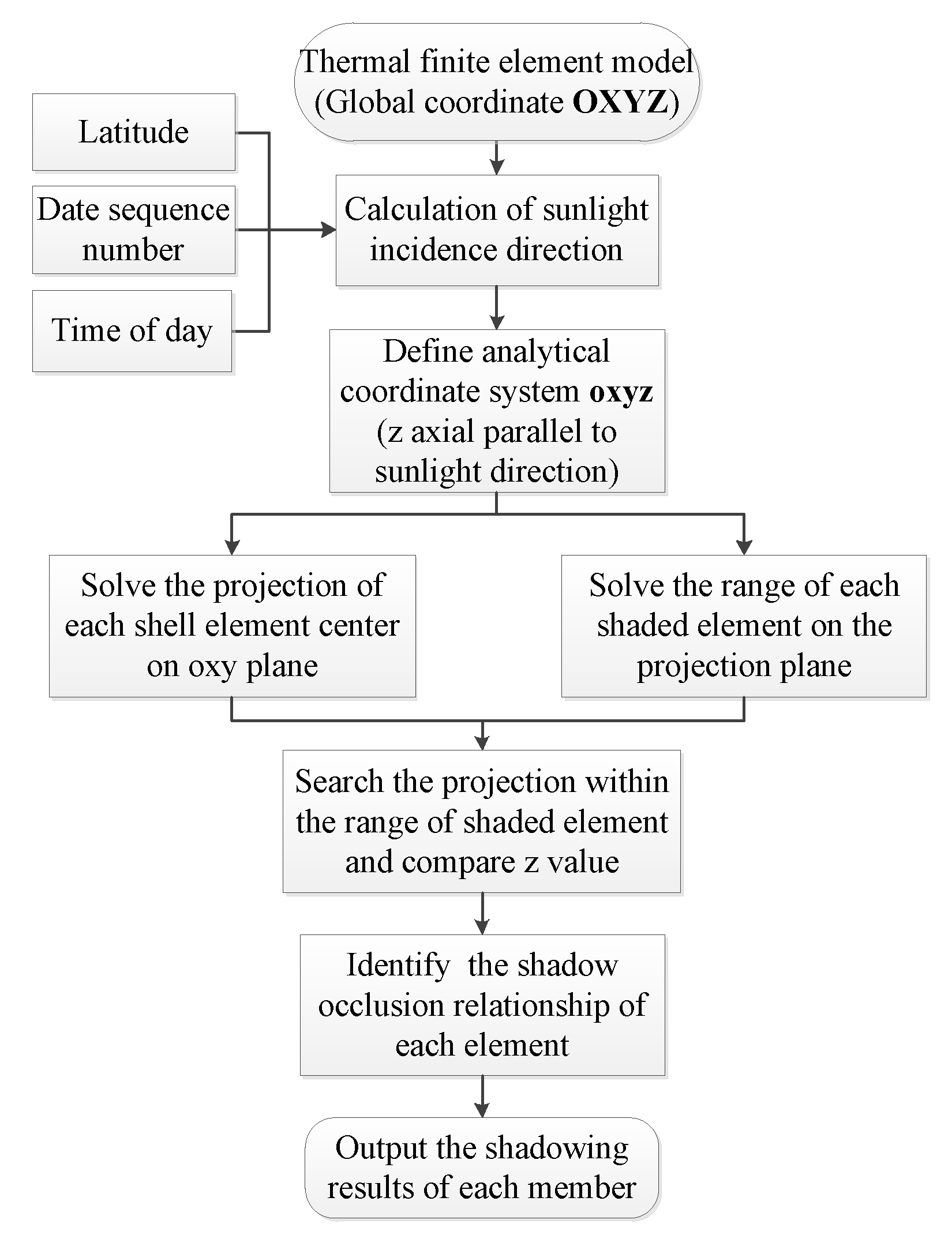


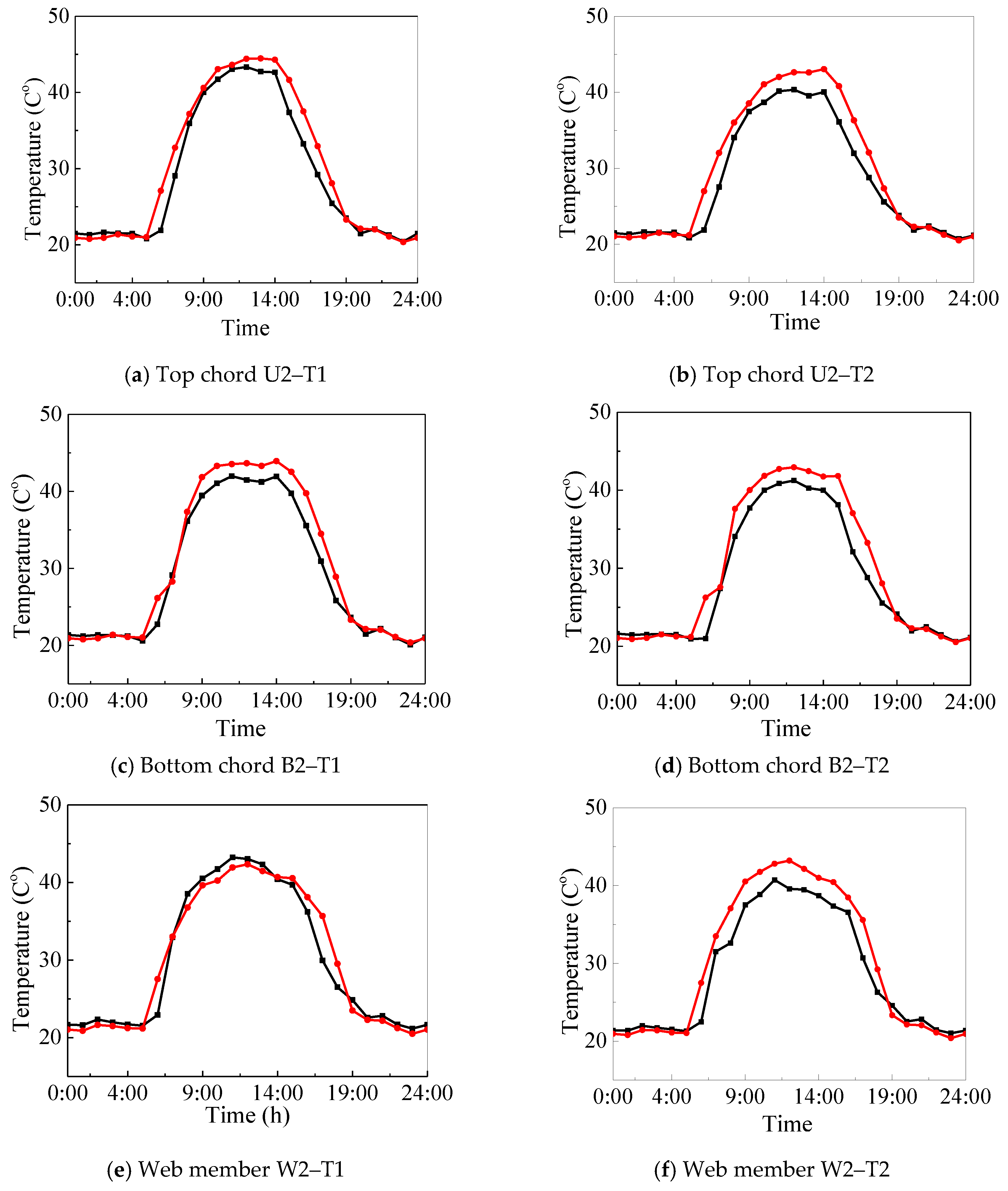
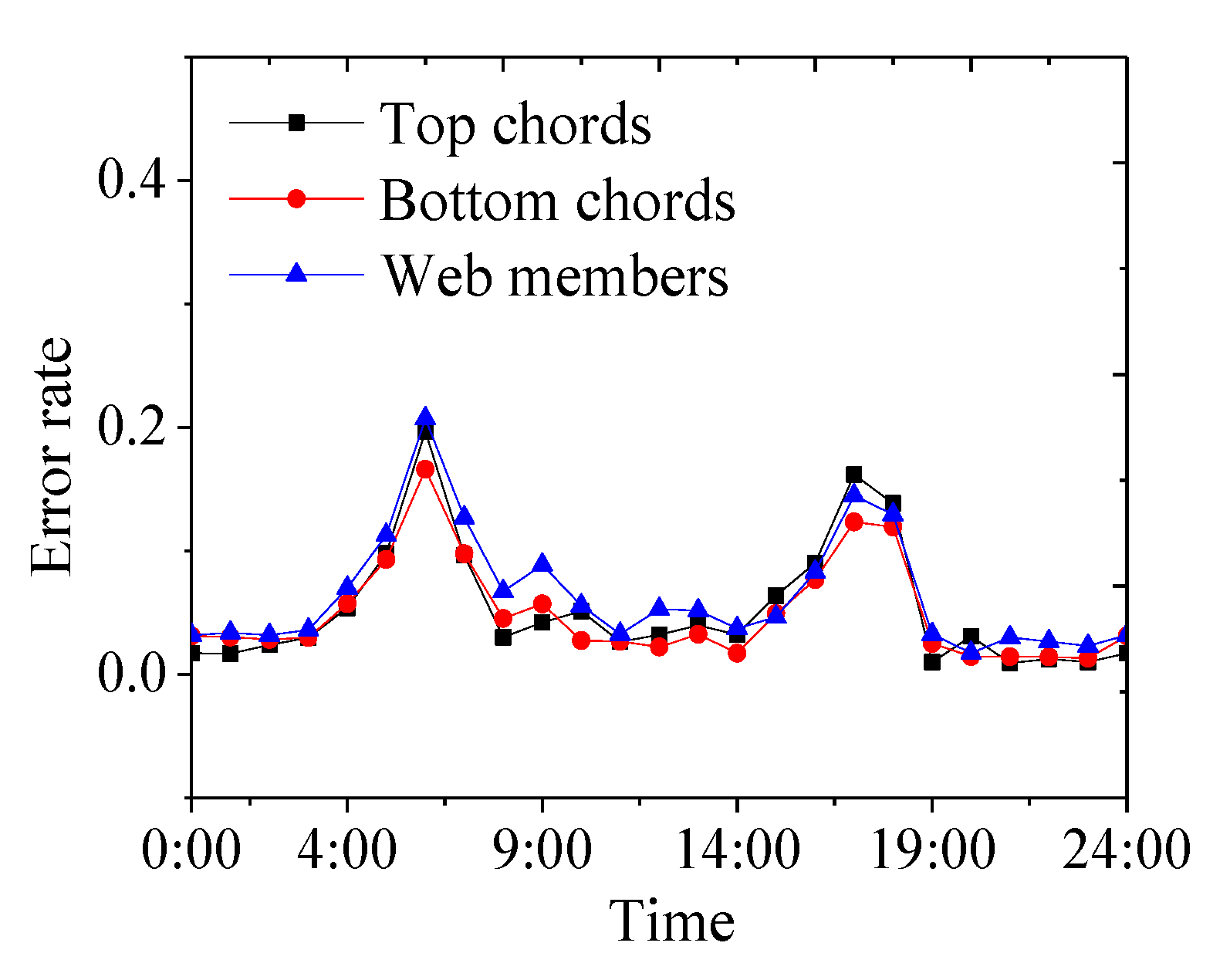
| Equipment | Image | Test Range | Precision | Manufacturer | Remarks |
|---|---|---|---|---|---|
| PT1000 Temperature Sensor |  | −60 to 260 °C | ±0.3 °C | NGN INSTRUMENT, Nanjing, Jiangsu, China | Waterproof Temperature test of solid, liquid, and air |
| Atmosphere Temperature Sensor |  | 0–40 °C | ±0.5 °C | JINGXUN ELECTRON, Weihai, Shandong, China | Real-time and wireless data acquisition |
| RS485 Solar Power Sensor |  | 0–1500 W/m2 | ±1 W/m2 | JINGXUN ELECTRON, Weihai, Shandong, China | Real-time and wireless data acquisition |
| Three-Cup Anemometer |  | 0–30 m/s | ±1 m/s | JINGXUN ELECTRON, Weihai, Shandong, China | Real-time and wireless data acquisition |
| TST3826 Temperature Acquisition Box |  | 60 Channels | - | TEST ELECTRON, Jinjiang, Jiangsu, China | Timing data acquisition system of temperature, stress, and strain |
© 2020 by the authors. Licensee MDPI, Basel, Switzerland. This article is an open access article distributed under the terms and conditions of the Creative Commons Attribution (CC BY) license (http://creativecommons.org/licenses/by/4.0/).
Share and Cite
Chen, D.; Qian, H.; Wang, H.; Xu, W.; Li, J. Non-Uniform Temperature Field of Spatial Grid Structure under Construction Induced by Solar Radiation. Appl. Sci. 2020, 10, 2445. https://doi.org/10.3390/app10072445
Chen D, Qian H, Wang H, Xu W, Li J. Non-Uniform Temperature Field of Spatial Grid Structure under Construction Induced by Solar Radiation. Applied Sciences. 2020; 10(7):2445. https://doi.org/10.3390/app10072445
Chicago/Turabian StyleChen, Deshen, Hongliang Qian, Huajie Wang, Wucheng Xu, and Jingfang Li. 2020. "Non-Uniform Temperature Field of Spatial Grid Structure under Construction Induced by Solar Radiation" Applied Sciences 10, no. 7: 2445. https://doi.org/10.3390/app10072445




